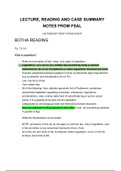LECTURE, READING AND CASE SUMMARY
NOTES FROM FSAL
LECTURES BY PROF FATIMA ESSOP
BOTHA READING
Pg 15-34:
What is Legislation?
- Rules and principles of stat. interp. only apply to legislation
- Legislation: (aka statute law) written law enacted by body or person
authorised to do so by Constitution or other legislation. Enacted law texts.
- Enacted: adopted/issued/promulgated in terms of prescribed legal requirements
(e.g constitution and Interpretation Act of ‘57)
- Law: has force of law
- Text: written law
- All of the following: Acts, statutes (generally Act of Parliament, sometimes
subordinate legislation regulating university), ordinances, regulations,
proclamations, rules, notices (eiter kind of subordinate leg or just an actual
notice, if in a gazette) & by-laws are all Legislation
- Categorized by chronological order and hierarchical power structures
- Must be published in official gazette to take effect (note: not everything published
in gazette is leg)
What the Interpretation Act provides:
- NOTE: provisions of this act do not apply to common law, only to legislation. Law
in this act refers to any enactment having the force of law
- S2 of the Act and S239 of the Constitution define legislation; more in S101(3),
S140(3), S44,S104,S156
, - Legislation is enacted from 1) geographical areas (national, provincial and local
authorities) 2) (horizontal) time-line (old order and post-1994) 3) (vertical)
hierarchical order (instruments of subordinate leg
Categories of Legislation:
1. Chronological categories- historical origins
2. Hierarchical categories- status in legal order
- Differences have an impact on commencement and demise of legislation
1. Chronological
a) Legislation pre-1806
- Statutes of the Staten-Generaal of the Netherlands and Placaaten of Holland still
in force
- Became part of SA law with no formal procedures required for demise (abrogated
by disuse)
- No definitions of leg nor rules of statutory interp apply to them
b) Old order legislation
- Defined in item 2 of Schedule 6 of the Constitution: any legislation that took force
before interim Constitution took effect 27 April 1994
Constitutional Highlights (understand complexities)
- 31 May 1910- four British colonies formed Union of South Africa (united
in terms of the South Africa Act)
- 1931: Union of South Africa became independent within British
Commonwealth (after Statute of Westminster adopted by brits)
- 1955: Freedom Charter adopted by Congress Of the People
(extra-parliamentary group) in Kliptown
- 31 May 1961: South Africa became a Republic (left Commonwealth)
after the South Africa Constitution Act 32 of 1961
, - 1983: Tri-cameral Parliament brought about by South Africa Constitution
Act 110 of 1983
- 1994: Democratic constitutionalism brought by South Africa Act 200 of
1983 (Interim Constitution) took effect on 27 April
- 1996: Constitution adopted by Constitutional Assembly and certified by the
Constitutional Court on 4 Feb 1997
Two Eras of Old Order
1. Pre-Union Legislation (1806-1910)
- British annexation- creation of Union of SA
- Leg of British colonies and Boer Republics
- Most either repealed or incorporated into Union and Republic but some
still in force
- Including: Lord’s Day Observance Act 19 of 1895 (Cape Province),
Sunday Act 28 of 1896 (Transvaal) and Police Offences Ordinance 21 of
1902 (Free State)
2. Legislation between Union and Democracy (1910-1994)
- Include most existing leg: Acts of Parliament, legislation of independent
homelands (TBVC states) , leg of self-governing territories (Kangwane,
Gazankulu, Lebowa, KwaZulu, Kwandebele & Qwaqwa), provincial
ordinances of white provinces (Transvaal, Cape, Orange Free-State and
Natal (‘10-’86)) , proclamations of administrators of four provinces when
provincial councils abolished (86-94) , by-laws enacted by local authorities
(town councils and municipalities) and subordinate legislation.
c) New constitutional legislation (post-1994)
- Interim const (repealed)
- 1996 Constitution
- National, provincial and local legislation
- Other regulations and proclamations
, 2. Hierarchical
- Pre-1994: Constitution not supreme but classification of leg simple: Original leg
(e.g. Acts of Parliament) and subordinate leg (e.g. regulations and
proclamations)
- Post-1994: Constitution supreme; old and new order leg; three branches of gov.
Leg issued by admin (aka subordinate leg) now referred to as delegated leg (but
const calls it subordinate)
a) The Constitution
- Supreme, obligations must be fulfilled and no inconsistency outside allowed
- Not just Act 108 of 1996: too high, not enacted by parliament but Constitutional
Assembly (drafted) and Constitutional Court (certified)
- Citation of Constitutional Laws Act 5 of 2005- no act no. associated with
Constitution
- Call it the Constitution
b) Original Legislation
- Derives from an authorised legislative body (with complete and comprehensive
capacity)
- Status comes from:
- Enactment by democratically-elected, deliberative, law-making bodies
- Law making powers founded in Constitution
- directly- Parliament (S43(a); S104(1)) and municipalities (S43(c);
S156(1)(a))
- or indirectly- assigned by another Act of P or provincial leg (S44(1)(a);
S104(1)(b)(iii)), municipalities (S44(1)(a)(iii); S156(1)(b)) and provincial
acts (S104(1)(c);S56(1)(b))
Acts of Parliament:
- All since 1910
- 1910-1983: House of Assembly and Senate




